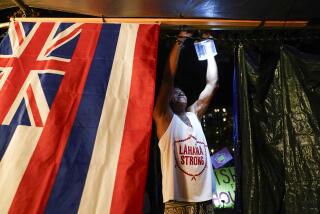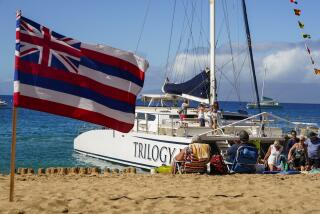Hawaii postpones reopening to tourism amid increased coronavirus cases

- Share via
Hawaii postponed easing rules that require tourists and locals to quarantine for 14 days when they enter the state. Starting Sept. 1, anyone who shows proof of testing negative for COVID-19 will be allowed skip mandatory two-week confinement.
On July 13, Hawaii’s Gov. David Ige pushed back the reopening to tourists from Aug. 1 to Sept. 1 because of a surge in coronavirus cases. The governor said he made the decision because of “uncontrolled outbreaks” of coronavirus in its main tourism markets, including California, according to a statement.
The state is seeing an increase in cases and expects more when schools reopen in August.
In Alaska and around Europe, airport coronavirus testing is taking wing.
Out-of-state travelers who want to avoid a long quarantine will have to have negative results (in an email or printed out) from a specific type of COVID-19 test within 72 hours in advance of travel. The test must be a nucleic acid amplification test, or NAAT, test conducted at a CDC-approved lab. Travelers will have to pay for the test, and testing will not be offered at Hawaii’s airports.
All travelers would need to be tested, including children. And if test results aren’t available when tourists arrive in Hawaii, they will be required to quarantine themselves.e tested. Also, anyone who arrives with a fever or other symptoms of the coronavirus will face medical screening before being allowed to leave the airport.
Ige’s original quarantine order in March, extended until July 31, was strict, including fines and penalties for locals and tourists who didn’t comply.

As the state slowly begins to reopen, some in the hospitality industry expect travelers to start trickling back.
Hawaiian chef and restaurateur Peter Merriman said hotel deals may initially lure tourists back. “There’s going to be a lot of people that are looking for a bargain,” he said. “There’s going to be bargains out there, so I think we’re going to get a lot of discount tourists initially in Hawaii.”
He also thinks high-end travelers — less affected by the country’s financial state — will return too, providing a boon for the upscale restaurants he operates on the islands of Hawaii, Kauai, Maui and Oahu.
What about hotels?
Officials with Aqua-Aston Hospitality, which operates 28 hotels and resorts in Hawaii, on Wednesday evening were beginning to develop reopening plans.
“We are looking forward to learning more about the state’s new pre-arrival testing program and to potentially being able to accept reservations for transpacific travelers from August and beyond,” Theresa van Greunen, an assistant vice-president, said in an email. Guests who book beginning July 6 for stays through Sept. 30 will have the option of canceling up to 24 hours ahead without penalty.
Airlines are expected to increase their flight volume in response to the governor’s action.
Hawaiian Airlines said Thursday morning that beginning Aug. 1 it will reinstate limited service from mainland U.S. (Long Beach, however, is not one of the airline’s immediate service areas.)
“Gov. Ige’s announcement will not result in an overnight return to the record visitor arrivals that we experienced in 2019,” Mufi Hannemann, president and chief executive of the Hawaii Lodging & Tourism Assn., said in a news release. “It simply will not happen.”
Nevada is the latest state to require people to wear face coverings in public indoor places to stop the spread of the novel coronavirus.
More visitors, even if greatly reduced from pre-pandemic times, will inevitably lead to more coronavirus cases.
“We do anticipate that we will get more cases,” Ige said. “But we have spent the last few weeks in building up our capacity to handle more COVID-positive cases.”
That increase worries Merriman, who said that August’s uptick in travel could be short-lived. “If the cases get too high, we’re going to have a real problem and people aren’t going to want to come to Hawaii at all,” he said. “It’s kind of like shooting a three-pointer [in basketball]. If it goes in, then great, you’ve got three points. But there’s a much higher probability you’re going to miss. And a miss in this particular case could cost us the game.”
Merriman said that Ige has been facing “phenomenal pressure” to reopen from many in the hospitality industry. The restaurateur realizes that people are desperate to get back to work, including the farmers who supply him with produce. “They had a lot of crops in the ground, and then business just shut off,” he said.
Before the pandemic, Hawaii had the lowest unemployment rate in the country. Now the state’s unemployment is second highest after Nevada, another state reliant on tourism.
Can pre-testing travelers keep numbers low? It’s not a “silver bullet,” Lt. Gov. Josh Green said at Wednesday’s news conference. “It’s not perfect, as we know, but a pre-test will minimize the risk that COVID-19 is imported into our state.”
More to Read
Sign up for The Wild
We’ll help you find the best places to hike, bike and run, as well as the perfect silent spots for meditation and yoga.
You may occasionally receive promotional content from the Los Angeles Times.






